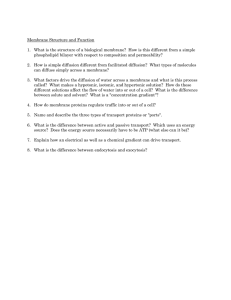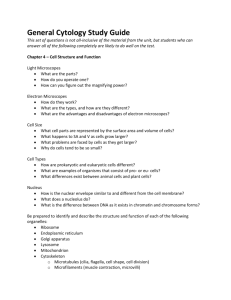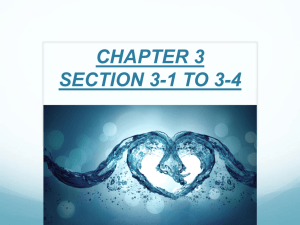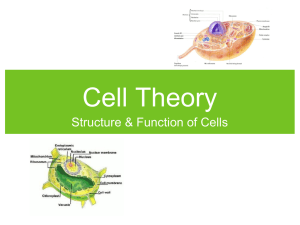Cell Membrane Chapter 3 and 4 – 9 Grade
advertisement
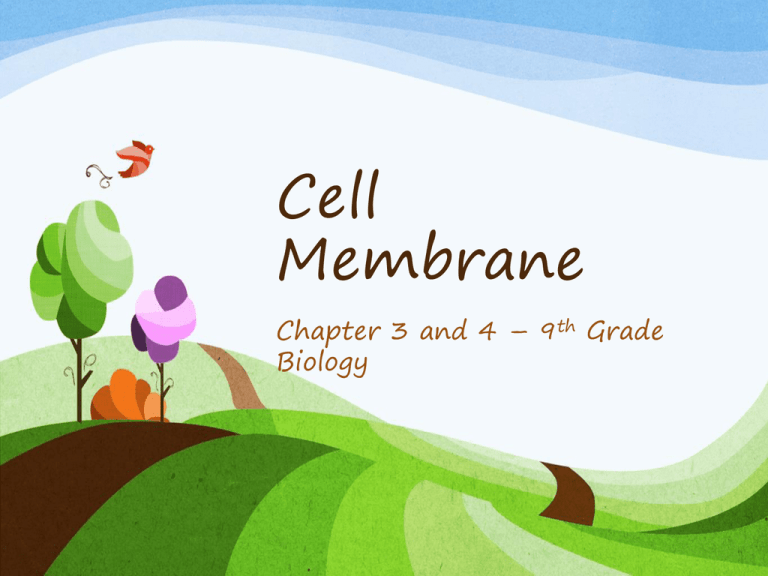
Cell Membrane Chapter 3 and 4 – 9th Grade Biology Cell Membrane (Plasma Membrane) • Outermost boundary of a cell • Encloses the cell’s cytoplasm and organelles from its surroundings • Regulates what enters and leaves the cell such as gases, nutrients, and waste. Cell Membrane Structure • Fluid structure (Not rigid like an egg shell) • The membrane can choose what enters and leaves the cell • Formed by a lipid (fat) layer The Phospholipid Layer • The lipid layer is made up of phospholipids • Phospholipid: a phosphate group with two fatty acids attached • Contains a polar “head” and two nonpolar “tails” POLAR HEAD NON-POLAR TAILS Phospholipids Structure • Polar “Head” is Hydrophilic or water loving • Non-polar “Tails” are Hydrophobic or water fearing Phospholipids Phospholipid Bilayer • Phospholipids form a bilayer to create the cell membrane The Phospholipid Bilayer This bilayer is selectively permeable – it determines what can enter and leave the cell using proteins Membrane Proteins • Membrane proteins are imbedded in the bilayer • Different types of proteins exist within the membrane: • Transport Proteins – Transports materials in and out of the cell using channels • Glycoproteins – Cell to cell communication • Receptor Proteins – Helps cells communicate with environment to form a reaction • Enzymes – Helps with reactions within the cell • Structural Proteins – Gives cell support and shape • Marker Proteins – Advertises cell type Proteins within the Membrane Crossing the Cell Membrane • Some substances like water can pass freely through the phospholipid layer • Other substances, like ions, need to use proteins to pass through due to size and polarity • Different methods may require or not require energy • Types of transport: PASSIVE and ACTIVE Passive Transport • This is the process of moving substances DOWN the concentration gradient to reach equilibrium • Uses NO energy • Types: Diffusion, Facilitated Diffusion, and Osmosis Passive Transport : Diffusion • The process that requires no energy and involves substances moving from an area of high concentration to an area of low concentration. • Diffuse means “to spread out” • Results from the random movement of molecules due to kinetic energy Passive Transport : Facilitated Diffusion • Facilitated diffusion is a type of passive transport • Carrier Proteins, a type of transport protein, uses this method. Facilitated Diffusion continued… • Transport proteins are needed to allow specific substances to pass into and out of the cell • Use channels, which are polar passageways, for ions and polar substances Ion Channels • Sodium (Na+), Potassium (K+), Calcium (Ca+2), and Chloride (Cl-) are used for very important cell functions • Functions such as nerve impulses, heart and muscle contraction • These ions cannot freely pass through the bilayer, so they need ion channels. Ion Channels • An ion channel may be always open, or only open when stimulated • This transport is passive, where no energy from the cell is required to move materials. Passive Transport : Osmosis • Osmosis is the diffusion of water down its concentration gradient through a semi-permeable membrane • Moving from low solute concentration to high solute concentration (High water concentration to low water concentration) • Solute molecules (sugar, ions) cannot pass through membrane so water must move across Osmosis • Hypertonic: Area with high concentration of solute • Hypotonic: Area with low concentration of solute Isotonic Hypertonic Hypotonic • Isotonic: Areas of equal concentration • http://www.youtube.com/watch?feature=fvwp&v=0c8ac UE9Itw&NR=1 Active Transport • This method involves moving substances AGAINST the concentration gradient. • Energy from the cell is required to move substances Sodium – Potassium Pump • Most important membrane pump in animal cells. • Active transport pumps sodium ions out of the cell and potassium ions into the cell.
